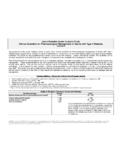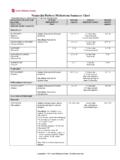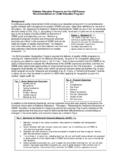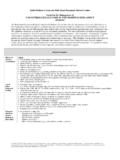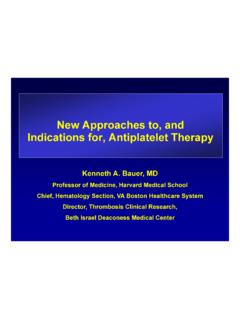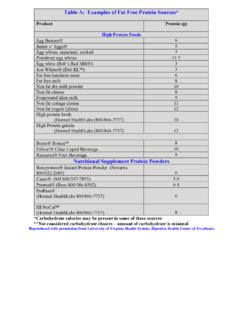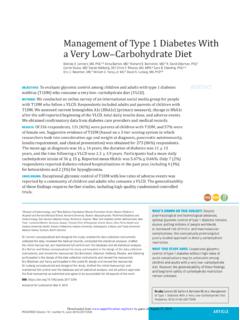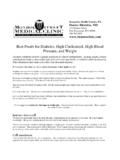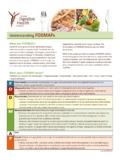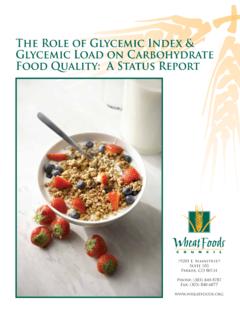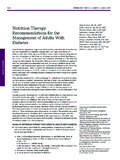Transcription of JOSLIN DIABATES CENTER & JOSLIN CLINIC
1 JOSLIN DIABETES CENTER and JOSLIN CLINIC . CLINICAL NUTRITION GUIDELINE FOR OVERWEIGHT AND OBESE ADULTS WITH TYPE 2. DIABETES, PREDIABETES OR THOSE AT HIGH RISK FOR DEVELOPING TYPE 2 DIABETES. 10-19-16. The JOSLIN Clinical Nutrition Guideline for Overweight and Obese Adults With Type 2 Diabetes, Prediabetes or Those at High Risk for Developing Type 2 Diabetes is designed to assist primary care physicians, specialists, and other healthcare providers in individualizing the care of and set goals for adult, non-pregnant patients with type 2 diabetes or individuals at high risk for developing type 2 diabetes. This guideline focuses on the unique needs of those individuals. Several components of these guidelines complement the 2015 Dietary Guidelines for Americans, which is jointly developed by the Department of Health and Human Services and the Department of Agriculture. It is not intended to replace sound medical judgment or clinical decision-making and may need to be adapted for certain patient care situations where more or less stringent interventions are necessary.
2 The objectives of the JOSLIN Clinical Diabetes Guidelines are to support clinical practice and to influence clinical behaviors in order to improve clinical outcomes and assure that patient expectations are reasonable and informed. Guidelines are developed and approved through the Clinical Oversight Committee that reports to the Chief Medical Officer. The Clinical Guidelines are established after careful review of current evidence, medical literature and sound clinical practice. These Guidelines will be reviewed periodically and the JOSLIN Diabetes CENTER will maintain, upgrade or downgrade the rating for each recommendation when new evidence mandates such changes. JOSLIN 's Guidelines are evidence-based. In order to allow the user to evaluate the quality of the evidence used to support each standard of care, a modification of the GRADE system has been adopted. The table provided on page 6 describes the categories in which methodological quality and strength of recommendations have been classified.
3 Evidence levels are graded 1A through 2C, as indicated in brackets. Target Individuals *Target 2. Population BMI e 25 kg/m Type 2 Diabetes or and or Waistline e 40 /102 cm (men) [1B] Prediabetes IGT (impaired glucose tolerance) [1A]. e 35 /88 cm (women) IFG (impaired fasting glucose). or High Risk for Type 2 Diabetes The Metabolic Syndrome (AHA/NHLBI. criteria) [1B]. Family history of type 2 diabetes mellitus (first degree relative). Confirmed diagnosis of insulin resistance ( , high basal insulin). 2. * For Asian populations (South Asian Indians, East Asians and Malays) a BMIe 23 kg/m and a waistline e 35 /90 cm in men or e 31 /80 cm in women. [1B]. General Guidelines There is strong evidence that weight reduction improves insulin sensitivity and glycemic control, lipid profile, and blood pressure in type 2 diabetes and decreases the risk of developing type 2 diabetes in pre-diabetes and high-risk populations [1A].
4 Refer individuals to a registered dietitian (RD) experienced in diabetes and weight management for individualized medical nutrition therapy (MNT); care should be coordinated with an interdisciplinary team including the patient's PCP. [1B]. 1. To enhance effectiveness of MNT, it is recommended there be a series of 3-4 encounters with an RD lasting from 45-90 minutes beginning at diagnosis. Priorities for this population include: 1. Weight reduction. 2. Glycemic control as well as achieving blood pressure and LDL-cholesterol goals. 3. Meal to meal consistency in carbohydrate distribution for those with fixed medication/insulin programs. Copyright 2016 by JOSLIN Diabetes CENTER . All rights reserved. Any reproduction of this document, which omits JOSLIN 's name or copyright notice is prohibited. This document may be reproduced for personal use only. It may not be distributed or sold.
5 It may not be published in any other format without the prior, written permission of JOSLIN Diabetes CENTER , Publications 1. Department, 617-226-5815. 4. Individualization for cultural and food preferences ( vegetarian). 5. Adoption of a healthy eating pattern that is sustainable over time (The Mediterranean diet, the DASH (Dietary Approaches to Stop Hypertension) diet and a plant-based or vegetarian diet are examples of healthy dietary patterns). 6. Integration of behavior change therapies in order to adopt healthy eating behaviors and sustainable weight loss The meal plan composition, described below, is for general guidance only and may be individualized by the RD or other healthcare provider according to clinical judgment, individual (patient) preferences and needs, and metabolic response. Physical activity is an integral component of a weight loss program for both initial weight loss and for weight maintenance.
6 Weight Reduction 1. A structured lifestyle plan that combines dietary modification, activity, and behavioral modification, along with ongoing support, is necessary for weight reduction. [1B] To maintain long-term weight loss; ongoing weight maintenance counseling and support is recommended. 2. A modest and gradual weight reduction of one to two pounds every one to two weeks should be the optimal target. [2A]. Reduction of daily caloric intake should be between 250 - 750 calories. [1C] Total daily caloric intake should not be less than 1000-1200 for women and 1200-1600 for men, or based on a RD assessment of usual intake. [1C]. 3. A 5-10% weight loss may result in significant improvement in blood glucose control among patients with diabetes and help prevent the onset of diabetes among individuals with pre-diabetes. [1B]. Weight reduction should be individualized and continued until an agreed upon BMI and/or other metabolic goals are reached.
7 4. Target individuals should meet with a RD to discuss a structured MNT plan for weight management that includes menus and snacks and to learn and practice portion control as effective ways of weight management. [1B]. 5. Diabetes-Specific Meal Replacements (DSMR) in the form of shakes, bars, ready-to-mix powders, and pre-packaged meals that match these nutrition guidelines may be effective in initiating and maintaining weight loss. Meal replacements should be used under the supervision of a RD. When meal replacements are initiated, glucose levels should be carefully monitored and if needed, antihyperglycemic medications should be adjusted. Meal replacements should be used with caution by those with hyperkalemia. 7. Bariatric surgeries, although not without medical and nutrition risks, are effective options and may be discussed when 2 2. indicated (consider in individuals with BMI e40 kg/m and those with BMI e35 kg/m with other comorbidities, reduce 2.)
8 By for Asians). [2B] To date, there is limited evidence to support the recommendation of bariatric surgeries 2. for patients with BMI <35 kg/m even if a person has diabetes or other co-morbid conditions. 8. Anti-obesity medications may be considered for patients who were not able to lose weight through lifestyle modifications, but the long- term risks and benefits of these medications are unclear [2C]. 9. The effect of diabetes medications should be evaluated throughout the weight loss program and adjusted as necessary to avoid hypoglycemia. Macronutrient Composition Fat Amount There is general agreement that the type of fat consumed is more important than the quantity (generally 30-40% total calories). (2,4,5). Trans fat from partially hydrogenated oil should be eliminated [1B] (16). Monounsaturated and polyunsaturated fats should comprise the majority of fat intake [2B] (3, 8, 16).
9 Limit saturated fat intake to <10 % of total calories. (4, 5, 9, 16). o Recent evidence demonstrates saturated fat from dairy foods (milk, yogurt, cheese) may be acceptable within the total daily caloric intake [2B]. o Despite recent evidence suggesting that saturated fat poses a weak or neutral effect on health, further research in this area is warranted. (2,9). Low-fat diets are generally less effective than low-carbohydrate diets for weight reduction [2 C] (2a, 3, 26, 27, 58, 59, 60 ). Recommended Plant fats rich in mono and polyunsaturated fats ( , olive oil, canola oil, soybean oil, nuts/seeds, and avocado [2A] (7, 14, 15). Oily fish rich in omega-3 fatty acids ( , salmon, herring, trout, sardines, fresh tuna) 2 times/week, as a source of omega-3 fatty acids. [2B]. Not Foods high in saturated animal fat, including, non-lean pork, lamb, and beef, Recommended processed meat, butter and cream Foods high in trans-fats ( , fast foods, commercially baked goods, margarines Copyright 2016 by JOSLIN Diabetes CENTER .))
10 All rights reserved. Any reproduction of this document, which omits JOSLIN 's name or copyright notice is prohibited. This document may be reproduced for personal use only. It may not be distributed or sold. It may not be published in any other format without the prior, written permission of JOSLIN Diabetes CENTER , Publications 2. Department, 617-226-5815. from partially-hydrogenated oil). Protein Amount Protein intake should range between of adjusted body weight [(Adjusted Body Weight = IBW (Ideal Body Weight) + of excess weight (Excess weight =. Current Weight - IBW)]. This amount generally accounts for 20-30% of total caloric intake. A modest increase in protein reduces appetite and assists in achieving and maintaining weight reduction. [2B] Protein also helps to minimize loss of lean body mass during weight reduction [2 B] (10, 26, 38). There is no reliable scientific data to support a protein intake that exceeds 2 gm/kg of adjusted body weight.
